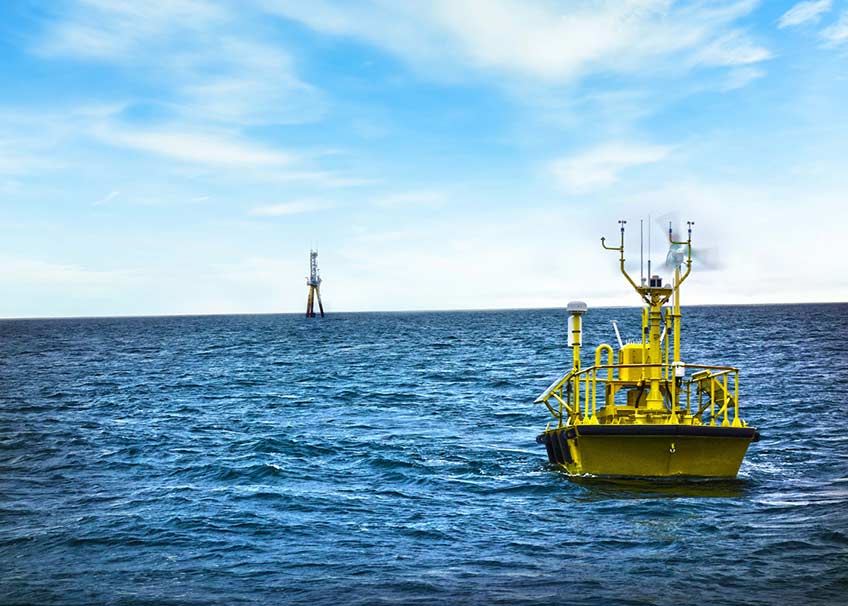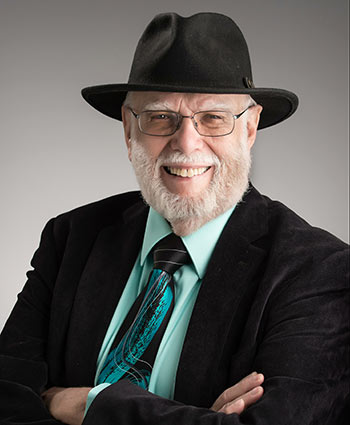The Leading Edge: August 2020 Wind Energy Newsletter
Happy American Wind Week! Get to know offshore wind better through NREL's wind resource characterization efforts, learn about an important Flatirons Campus power upgrade, and look at the remarkable career of Bob Thresher.
News Stories
Buoys stationed off U.S. coasts, such as this one managed by Pacific Northwest National
Laboratory, collect meteorological and oceanographic data that can help the wind industry
make informed decisions for offshore wind power plants. Image courtesy of Ocean Tech Services LLC and Pacific Northwest National Laboratory
Tomorrow's Forecast: Sunny with a Strong Chance of Wind
How strong and steady will the wind blow? In what direction and at what time? The answers can have serious implications for wind energy systems.
NREL meteorologists, engineers, and geographic information system experts are leading wind resource characterization efforts essential to the development of offshore wind. In collaboration with industry, academic, and government partners, the laboratory is providing the measurements, data, and modeling needed for decisions by policymakers and commercial enterprises.
In addition to the article, keep tabs on the Wind Energy Science Leadership Series to learn more about atmospheric science in wind energy research.
NREL Floats New Offshore Wind Cost Optimization Vision
A recent NREL study unveils a new strategic vision for floating offshore wind. Researchers identify barriers that must be overcome to bring down the overall cost of energy produced, then outline a vision for an integrated systems approach that could significantly improve the market feasibility of floating wind power plants.
Increasing Power Expands Research Capabilities at NREL's Flatirons Campus
In partnership with Xcel Energy, the U.S. Fish and Wildlife Service, and the Department of Energy (DOE), NREL completed its Power Generation Upgrade Project, doubling available power at NREL's Flatirons Campus from 10 megawatts (MW) to 19.9 MW, further enhancing research capabilities to explore integrated energy systems at scale and the incorporation of distributed energy resources into the grid through initiatives like the ARIES (Advanced Research on Integrated Energy Systems), which will make it possible to understand the impact and get the most value from the millions of new devices—such as electric vehicles, renewable generation, hydrogen, energy storage, and grid-interactive efficient buildings—that are being connected to the grid daily.

From "Budget Rent-a-Prof" to Man in the Black Hat. Meet Bob Thresher. Photo by Dennis Schroeder, NREL
Hats off and Happy Trails to NREL Wind and Water Pioneer
In July, our longtime mentor, friend, and colleague Bob Thresher officially retired after more than 35 years of dedicated service to NREL. Bob's contributions to both wind and marine energy sciences are significant, and you can read more about his remarkable journey and career tribute.
On the Radar
IEA Wind Task 26 Details Land-Based Wind Energy Cost Trends in Europe and the United States
A recent study published in the journal Applied Energy covers technological and cost trends in land-based wind energy in six participating countries (Denmark, Germany, Ireland, Norway, Sweden, and the United States) between 2008 and 2016.
The publication is part of NREL's work with IEA Wind Task 26, an international group that NREL leads as the operating agent that provides information on the cost of wind energy to understand past and present trends and to anticipate future trends.
The study finds a general trend toward larger, taller machines with longer blades and larger rotors, allowing them to capture more energy and run a greater percentage of the time, including at lower wind speeds. Factor in falling capital and financing costs—along with the observed trends in operating costs, taxation, and depreciation—and you get a 33% decrease in average levelized costs of energy for new land-based wind projects over the study period.
Despite these gains, growing wind capacities also impact wholesale electricity prices in many countries, resulting in changes to the value of wind energy itself relative to the wholesale price of electricity/ (When the value of wind equals the wholesale price of electricity, one has realized the concept known as grid parity.)
So, what does this mean?
It means that further cost reductions or enhanced value creation are likely necessary to continue to drive wind energy to be one of the world's primary sources of electricity.
Fortunately, the cost of land-based wind will not remain stagnant as further technological advancements continue to drive down the cost of wind energy. Coupled with efficiency gains that emerge as we gain more experience and knowledge on how to economically capture and utilize wind energy, a wind powered future may sweep in sooner rather than later.
New Competitiveness Improvement Projects Announced
On Aug. 11, DOE announced eight new Competitiveness Improvement Project (CIP) projects that will help make distributed wind energy more cost competitive, improve its interoperability with other distributed energy resources, and increase the number of small- and mid-scale wind turbine designs certified to national testing standards. Reflecting the trend observed with larger wind turbines, most of these projects are developing small- or medium-size wind turbines with longer blades and larger rotors, allowing them to capture more energy even in areas with lower wind speeds.
NREL manages CIP on behalf of DOE's Wind Energy Technologies Office. Since 2013, NREL has awarded 36 subcontracts to 20 companies, totaling $7.75 million of investment, while leveraging $3.79 million in additional private-sector funding. The August 2020 selections add $2.6 million in DOE funding, bringing the total DOE investment to over $10 million and leveraging more than $5 million in industry cost-share.
Downwind: In Case You Missed It
ExaWind Update
Reported on by offshoreWIND.biz, engineers from General Electric (GE) have been granted access to the Summit supercomputer at Oak Ridge National Laboratory (ORNL) in Tennessee through DOE's competitive Advanced Scientific Computing Research Leadership Computing Challenge.
As part of the project, GE will work with research teams at NREL and ORNL to advance the ExaWind platform, which focuses on developing computer software to simulate different wind farm and atmospheric flow physics.
Roadmap Outlines Framework To Improve Wind Industry Cybersecurity
NREL researchers contributed to a multilaboratory report that outlines cyberthreat challenges and best practices the wind industry can use to improve cybersecurity. NREL’s research included aligning wind turbine communication elements with National Institute of Standards and Technology Cybersecurity Framework components, providing critical best practices for designing a secure network architecture for wind farms, studying international wind turbine standards, and mapping technical working groups within the International Electrotechnical Commission. The Wind Energy Cybersecurity Roadmap's strategies, although specific to wind, could apply to other forms of energy and industrial control systems.
Publications
Assessing the Blockage Effect of Wind Turbines and Wind Farms Using an Analytical Vortex Model
This article presents a novel methodology to assess wind farm production while accounting for blockage effects, which are currently neglected in the prediction of wind farm energy yield―typically leading to an overestimation of production. The authors apply a vortex model based on a cylindrical wake to assess induction effects and present variations of the model to account for finite wake length, finite tip‐speed ratios, and the proximity to the ground. The flow modeling of wind farm prediction tools can be improved by using the methodology presented in this work.
Additive Manufacturing of Soft Magnets for Electrical Machines – A Review
With growing interest in electrification from clean energy technologies, such as wind power and use of pure electric powertrains in various applications, the demand for next-generation, high-performance magnetic materials has risen significantly. Additive manufacturing opens new venues of improvements for industrial manufacturing of electrical machines. This article summarizes the state of the art in printability and performance characteristics of soft magnetic materials for electric machines as well as the prospects of soft magnetic materials selection in terms of price, printability, weight, and performance of the electrical machines.
Development of a Time-Height Profile Assimilation Technique for Large-Eddy Simulation
Mesoscale-to-microscale coupling aims to address the limited scope of traditional large-eddy simulations by driving microscale wind-plant flows with information concerning large-scale weather patterns provided by mesoscale models or observational data. This article presents a new mesoscale-to-microscale coupling technique for horizontally homogeneous flow conditions, applied to NREL's in-house large-eddy simulations code. The profile assimilation technique gave the microscale solver a greater ability to correct modeled mesoscale time-height profiles and led to improved predictions of shear and turbulence statistics compared to reference meteorological mast data.
Multimodel Validation of Single Wakes in Neutral and Stratified Atmospheric Conditions
Understanding the interactions between wind turbines and their wakes within a stratified atmospheric boundary layer is key to improving modeling capabilities that enable more efficient design and operation of wind power plants. In this article, the authors consider 13 approaches to simulating wakes observed with a nacelle‐mounted lidar at the Scaled Wind Technology Facility under varying atmospheric conditions. They find that some of the main challenges in wind turbine wake modeling are related to simulating the inflow and share the main lessons learned from these simulations to inform future, similar efforts.
Share

